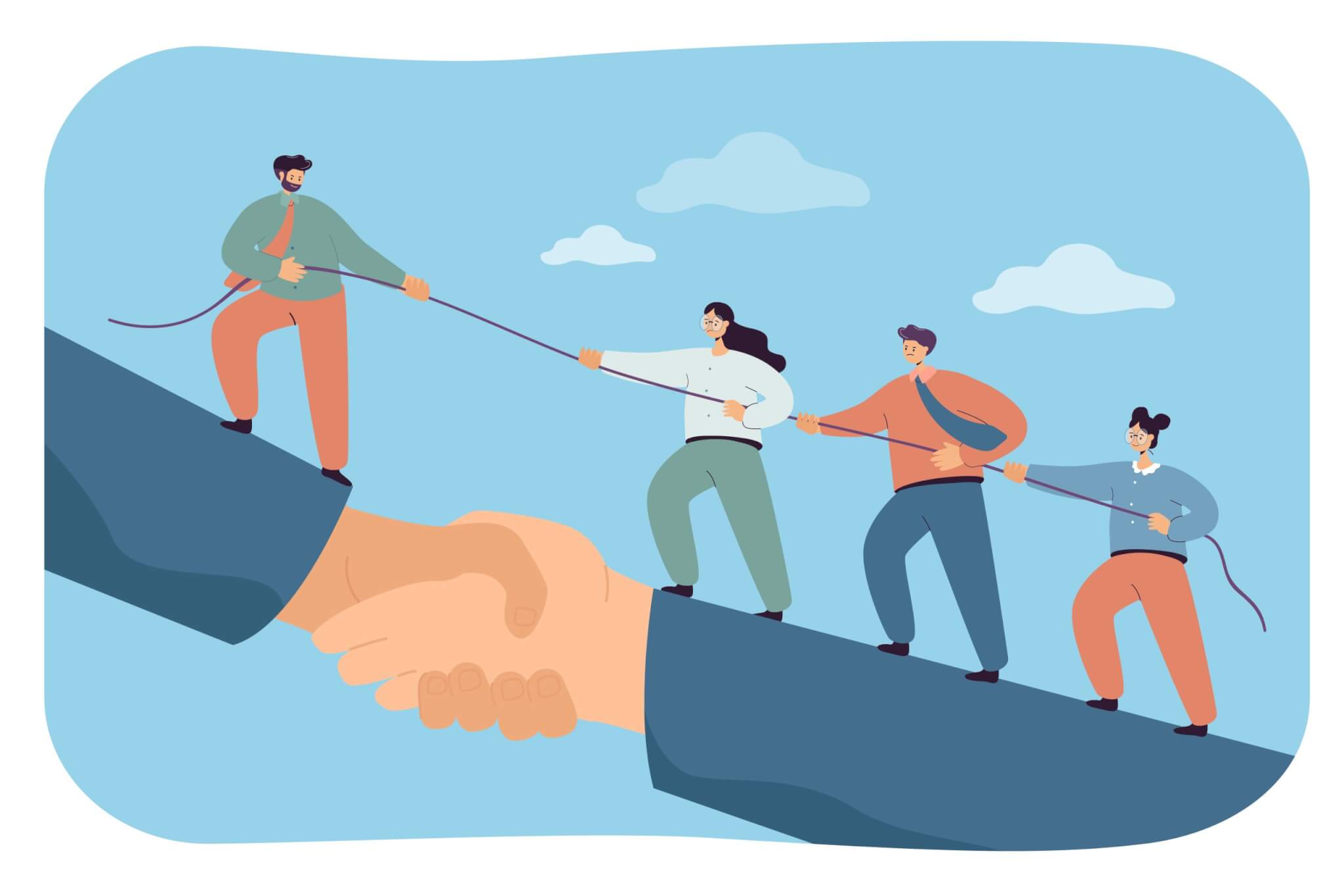
Bridging the Gap: 3 Interventions for Organizational Growth Mindset
This is part 2 in our blog series on Growth Mindset culture in organizations. We delve into the specifics through a series of articles on topics like organizational Growth mindset’s theoretical framework, its intervention architecture, and its link to organizational change management and change fatigue.
“The best way to treat obstacles is to use them as stepping stones. Laugh at them, tread on them, and let them lead you to something better.” – Enid Blyton

Source: https://www.freepik.com/vectors/business-help
Over 30 years ago, Stanford professor Carol Dweck theorized the importance of having a growth mindset (GM) over a fixed one, and its ability to spur innovation, increase employee engagement, and improve performance. Dweck postulated that individuals with a growth mindset “believe that their most basic abilities can be developed through dedication and hard work—brains and talent are just the starting point” (Dweck, 2015). She and her colleagues demonstrated that the way we interact, deliver feedback, and ask questions can subconsciously nudge an individual to a particular mindset.
Organizational Growth Mindset
Understanding this, organizations like Microsoft, NASA, and Google began to cultivate growth mindset in their company culture. It is worth noting that organizational growth mindset is another manifestation of organizational change management (OCM). And like other OCM initiatives, it is likely to face a series of challenges. Here you can think of fixed trait attribution, risk aversion, and a chain of inertia biases just to name a few. For example, we refuse to take reasonable risks, fearing that, in case of failure, our choices will seem foolish in hindsight and we will be unjustly blamed (risk aversion, Sibony, 2021).
Integrating GM is unique for each organization and it is therefore imperative to discover what works for your organization. Namely from brainstorming, developing and testing interventions to learning from that output and continuously improving. Despite the abundance of growth mindset interventions for settings like education, there seems to be a lack of actionable material for organizations. So why not bridge the gap? In addition to sharing a copy of Mindset: The New Psychology of Success with your colleagues, here is a list of 3 concrete and actionable interventions for cultivating a growth mindset in the workplace suitable for any organization:
- Priorities, Systems, Habits
- Deep Dives – Radical End User Perspective
- Language Toolkit
1) Priorities, Systems, Habits
This concept requires an organization’s shared commitment to the fundamental principles of GM – the idea that “skills and abilities can be improved, and the development of skills and abilities is the goal of the work you do” (NeuroLeadership Institute, 2018). This notion or ‘priority’ needs to be ‘systematically’ embedded in the organization while teaching the right growth mindset behaviors and ‘habits’. Consider these three factors (priorities, habits, and systems) as the key drivers of cultural change.
Let’s take a look at how Cigna (an American multinational healthcare services company) leveraged organizational growth mindset for performance improvement. In order to create an agile organization, senior leadership took the time to understand the science behind change. Specifically, how ‘quality conversations provide the information people need in order to adapt to new situations’ (NLI, 2018). In addition to this, they prioritized a consistent communication strategy. Through messaging, employees were provided examples of growth mindset, how to apply GM and methods for encouraging desired growth behaviors. Managers were also given quality coaching conversions (e.g. growth mindset messaging). To reinforce the concept, leadership made sure to mention GM in internal speaking opportunities. They started hosting ‘lunch and learn’ sessions to encourage dialogue and social motivation. Simultaneously, individuals were empowered to share thoughts and strategies.
Regarding habits, during employee performance conversations, goals are now set in a way that expects employees to expand their current abilities. Another habit the organization has adopted is to deliberately include GM language such as ‘yet’ and ‘what if’ (see intervention 3). The concept started to crystalize and started seeing the opportunity in everything’ and letting go of old procedures and not being afraid to try’ (NLI interview, 2018).
In 2015, Cigna made some GM based systemic changes to their hiring process. Namely, job descriptions began communicating the expectation for growth, passion for learning, and collaboration as opposed to talent and skills.
Which priorities, systems, and habits would you introduce?
2) Deep Dives – Radical End User Perspective
Deep dives as a strategy for change management…
Imagine this: You complete a leadership and development programme about Growth Mindset Management excited to implement strategies, ready to implement many top down ideas to make that shift from fixed to growth mindset, as well as embracing challenges and giving feedback. Can you think of a way, based on growth mindset principles, to improve this strategy?
It is crucial for any organizational change to have bottom up feedback. We need leadership that has control over processes and systems to have a fact based view of what people of the organization need from them to adopt and maintain OGM. An easy way to do this is to conduct Deep Dives. Here’s how you can do this:
- Select groups of stakeholders from all levels of the organization at the early stage of the Growth Mindset programme.
- Give an introduction to Growth Mindset.
- Discuss ‘Priorities, Systems, and Habits’ in a very open format in order to set up a quality dialogue. Many minds are at work here. Facilitators are key in debiasing these discussions and making sure that everyone is heard.
Sample Questions:
- What are the current learning opportunities? What would you like to see or change?
- How is feedback given? (e.g how frequent, in what way, etc..) How would you like to receive feedback? Are there 1-1s feedback sessions?
- Do managers have GM and strength based conversations with their organization? How do these conversations work? What is the expected outcome of these conversations?
- Does HR provide tips on how to manage any missing credentials people might have when applying for jobs that are outside their current responsibilities? If yes, what does this process look like?
- Are there formalities in place to challenge existing work processes? How easy is it to challenge existing processes? Are employees aware of these formalities and of past cases of processes being challenged?
Benefits of Deep Dives
Introducing Deep Dives, generates a bottom up stream of information for leadership to help them prioritize efforts and generate significant buy-in. Ultimately, GM is another manifestation of organizational change which only works if stakeholders feel that they are actively participating in creating the change, and not if they feel that the change is happening to them. Having these deep dives and discussions makes this process a lot more efficient and easier to gain ownership of making it happen. Moreover, this strategy gives insight into which behaviors and habits are needed in order to implement organizational growth mindset, and specify those behaviors to role model and communicate more effectively. Deep Dives also allow insight into which initiatives are already promoting a growth mindset, and uncover hurdles. Specifically, which changes need to be made to processes, ways of working, systems to facilitate the behaviors, and habits that make a growth mindset possible. Ultimately, they help to understand if the architecture of the organization truly facilitates GM.
Pro-tip: While you’re conducting these Deep Dives, it may be helpful to assign certain roles to be part of the discussion. Namely, a Devil’s advocate, end user, and ‘blue sky’ proponent.
- Devil’s Advocate: test arguments and ideas with a critical eye.
- End User: think and argue from the position of the end user, and how Growth Mindset impacts them. What processes would they benefit from?
- Blue Sky Thinker: For this role, no brainstorm is too crazy. Sky’s the limit.
Deep Dives are a strategy we have successfully implemented at a large energy company in the Netherlands. This strategy allows for a multi-directional, both top down and bottom up, approach of making Organizational growth mindset into lasting change.
3) Language Toolkit
The use of language is deeply ingrained in peoples’ work. A subtle yet powerful technique to foster GM is to create a shift in language. This could be in a conversation, an email, or meeting. Look out for the ways that language reflects thinking and slowly make the shift to using language that is future focused, collaborative, and in-control. For example:
Future-focused
- “Before X we could…” → “In the future we will be able to…”
- “ It used to be so much better when…” → “It will be better when..”
Collaborative instead of conflictive
- “You should have…” → “Next time…”
- “Don’t…” → “Do make sure that…”
In-control
- “I don’t know…” → “I will find out…”
- “That’s the way we were told to do it…” → “The areas we could improve are…”
Next, try switching from product praise to process praise.
It’s likely you’ve heard the ‘ ‘the power of ‘yet’’. This subtle addition can completely transform the heart of a sentence. ‘I don’t know’ can change to ‘I don’t know yet’. The addition of “yet” encourages you to continue along your learning journey, and implies you will eventually reach your goal.
Lastly, create sentence stems to help break old habits of negative thinking. For example;
- I’m not good at this → what am I missing?
- I give up → I’ll use a different strategy
- I made a mistake → Mistakes help me learn
We hope this article was useful to you and if you’re looking for a behavioral business partner who can drive change (growth mindset focused or not) in your organization, we’d love to schedule a call or coffee.
If you want to learn more about behavioral insights, read our blog or watch 100+ videos on our YouTube channel!
About Neurofied
Neurofied is a behavioral science company specialized in training, consulting, and change management. We help organizations drive evidence-based and human-centric change with insights and interventions from behavioral psychology and neuroscience. Consider us your behavioral business partner who helps you build behavioral change capabilities internally.
Since 2018, we have trained thousands of professionals and worked with over 100 management, HR, growth, and innovation teams of organizations such as Johnson & Johnson, KPMG, Deloitte, Novo Nordisk, ABN AMRO, and the Dutch government. We are also frequent speakers at universities and conferences.
Our mission is to democratize the value of behavioral science for teams and organizations. If you see any opportunities to collaborate, please contact us here.
